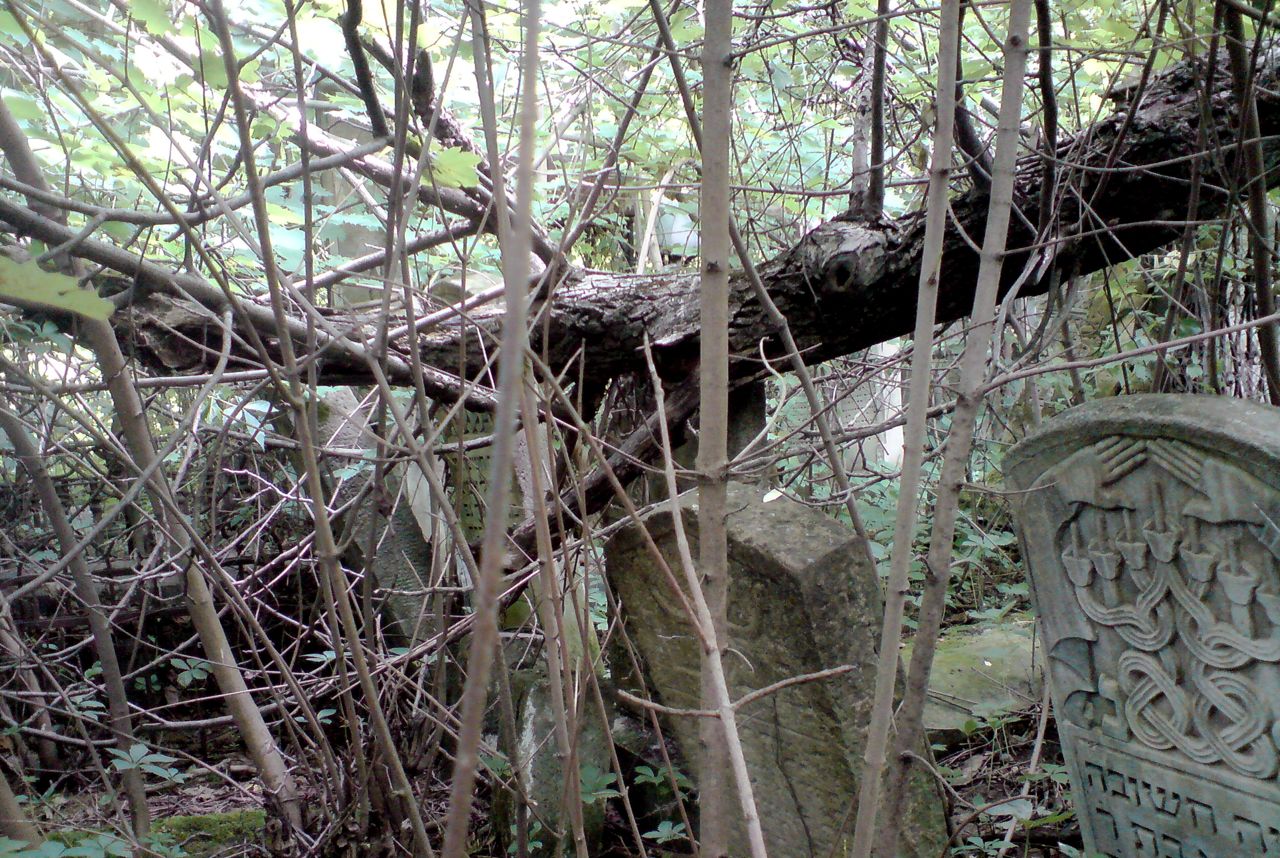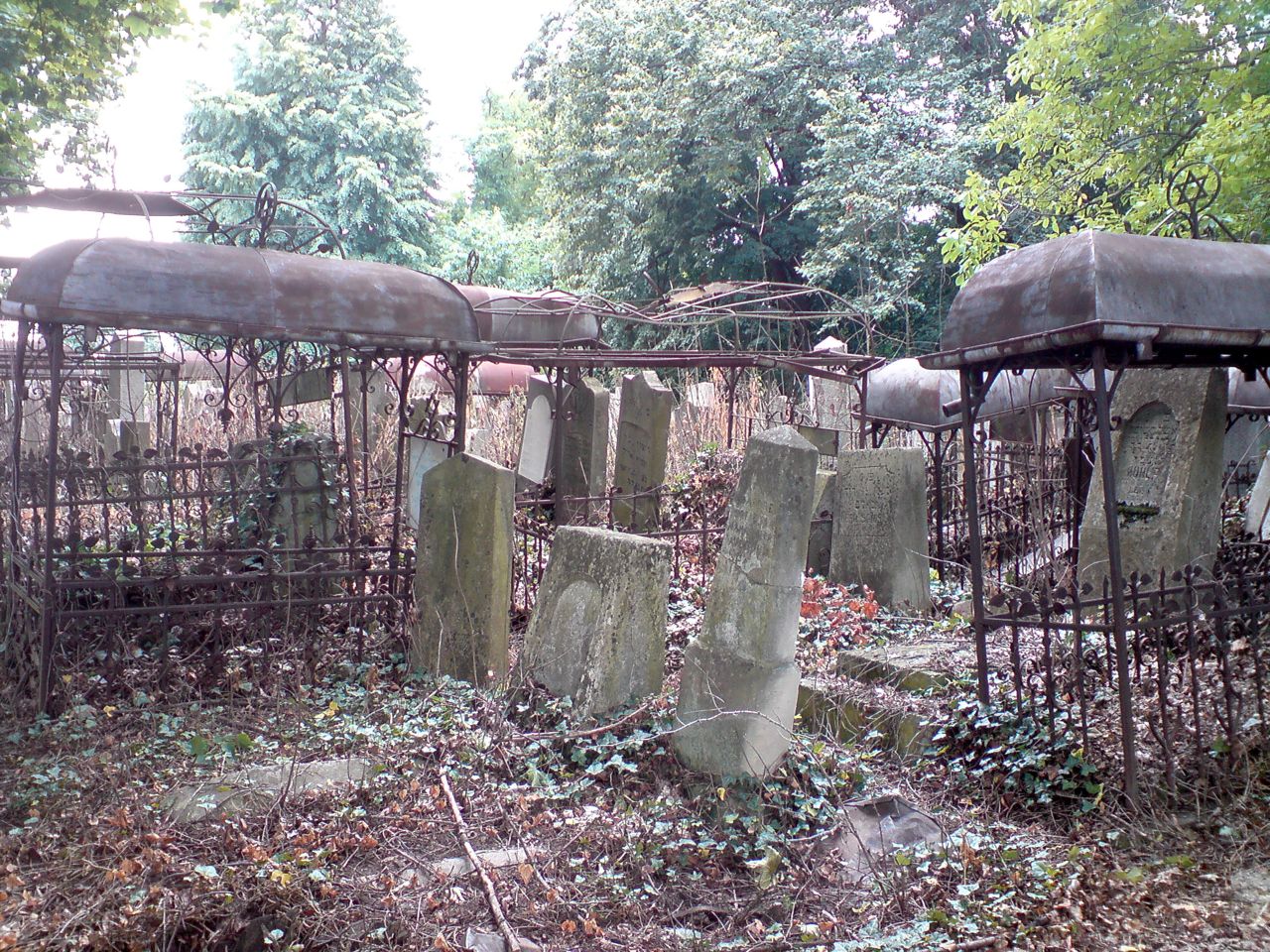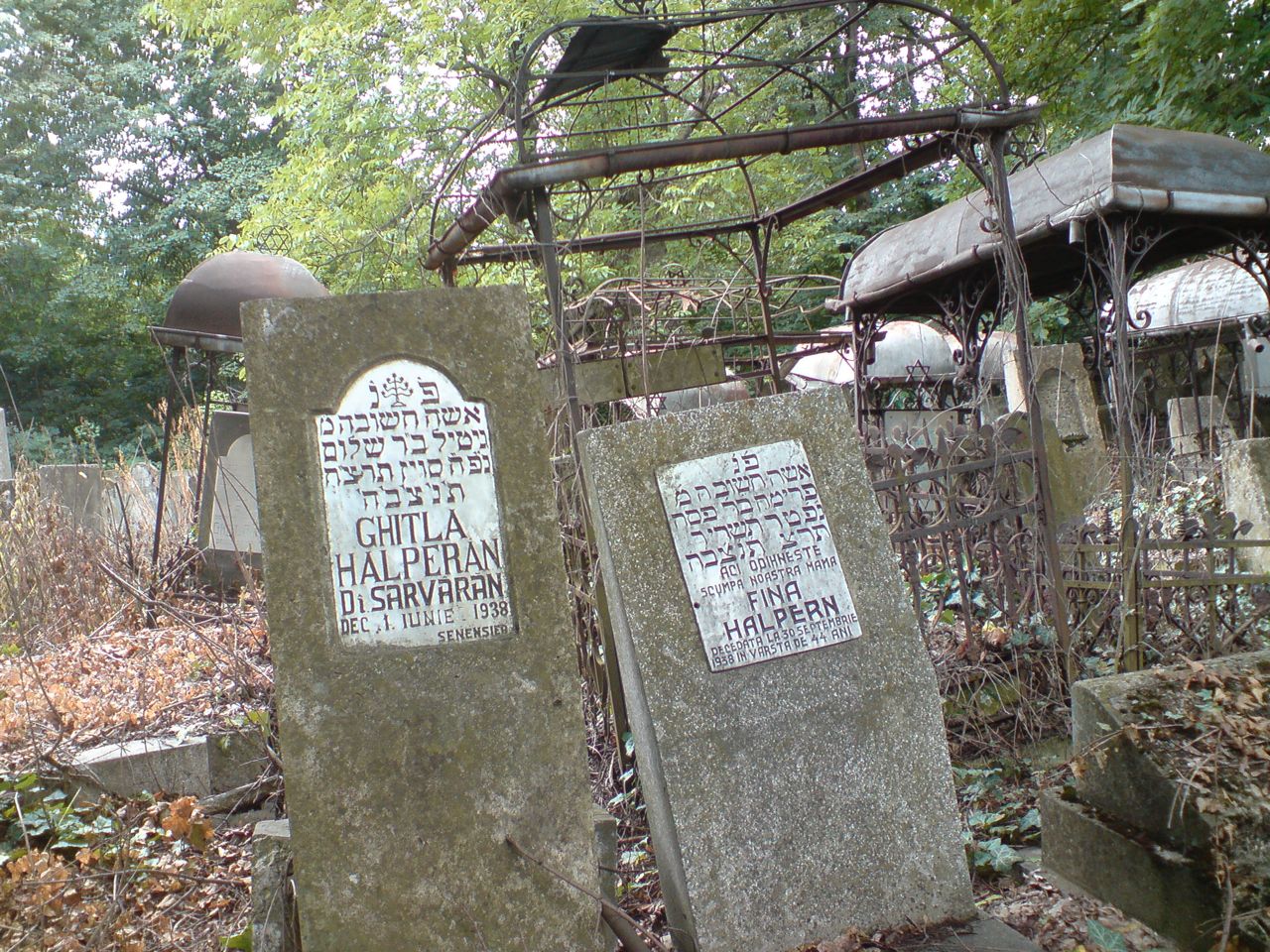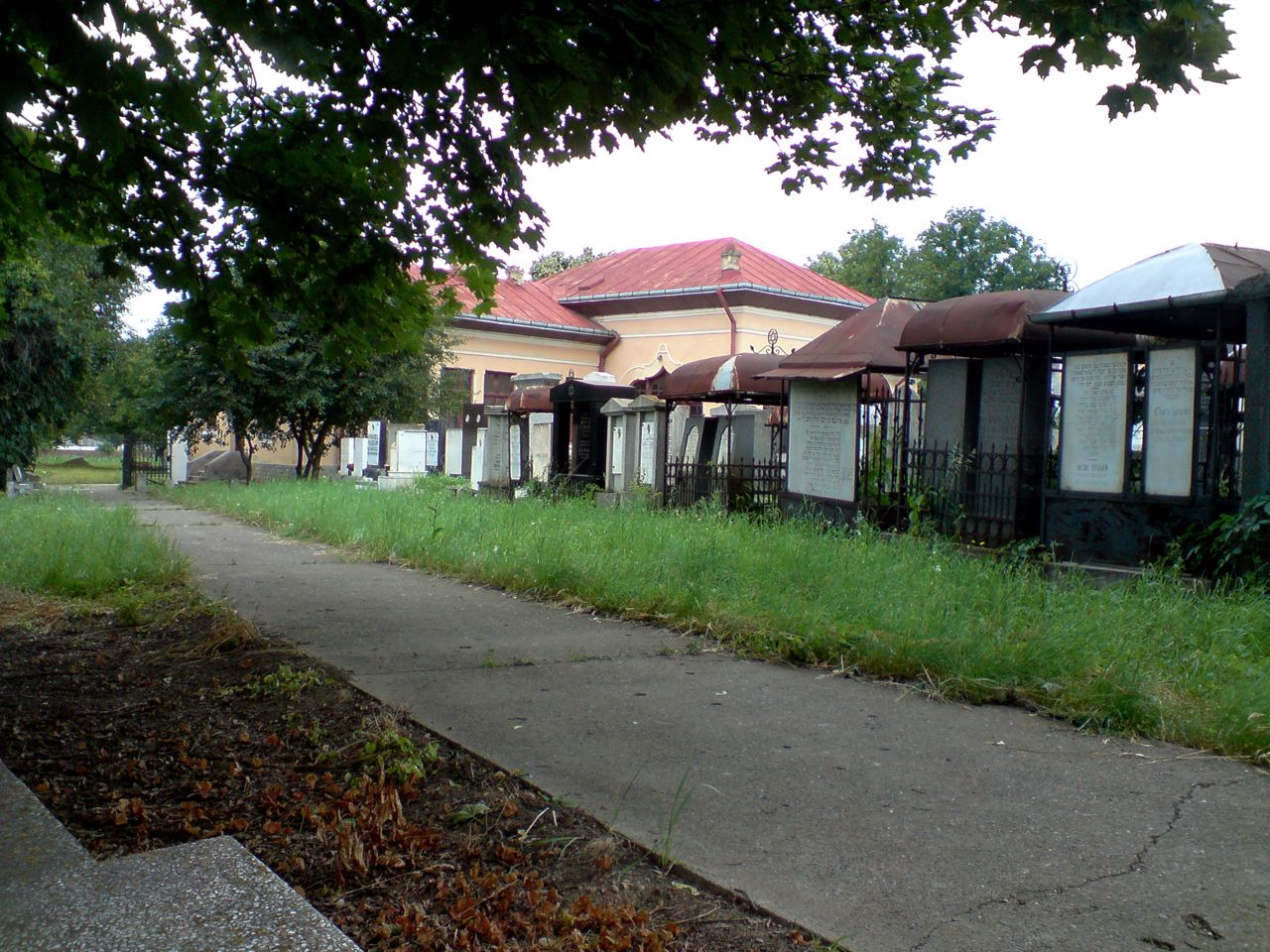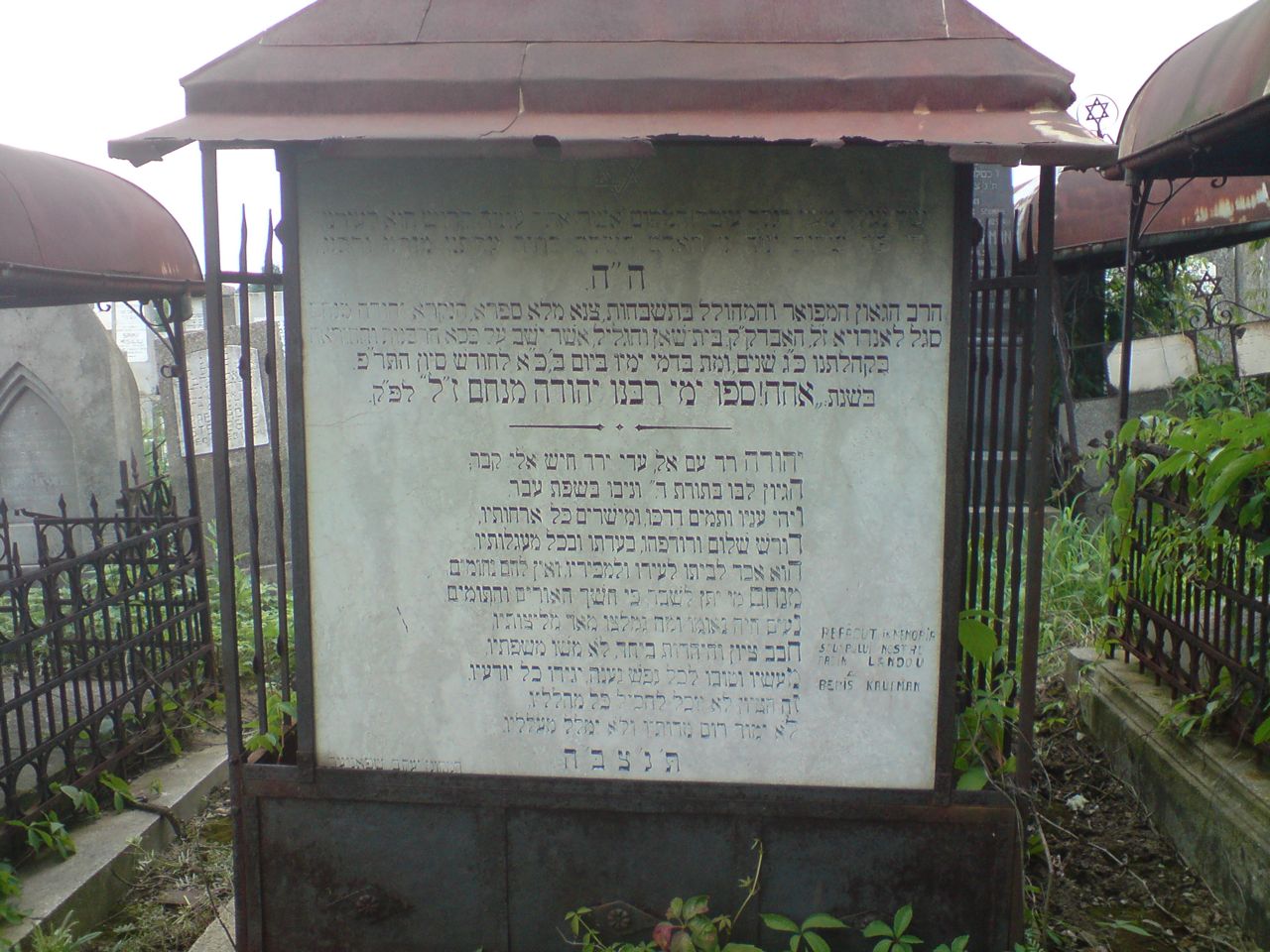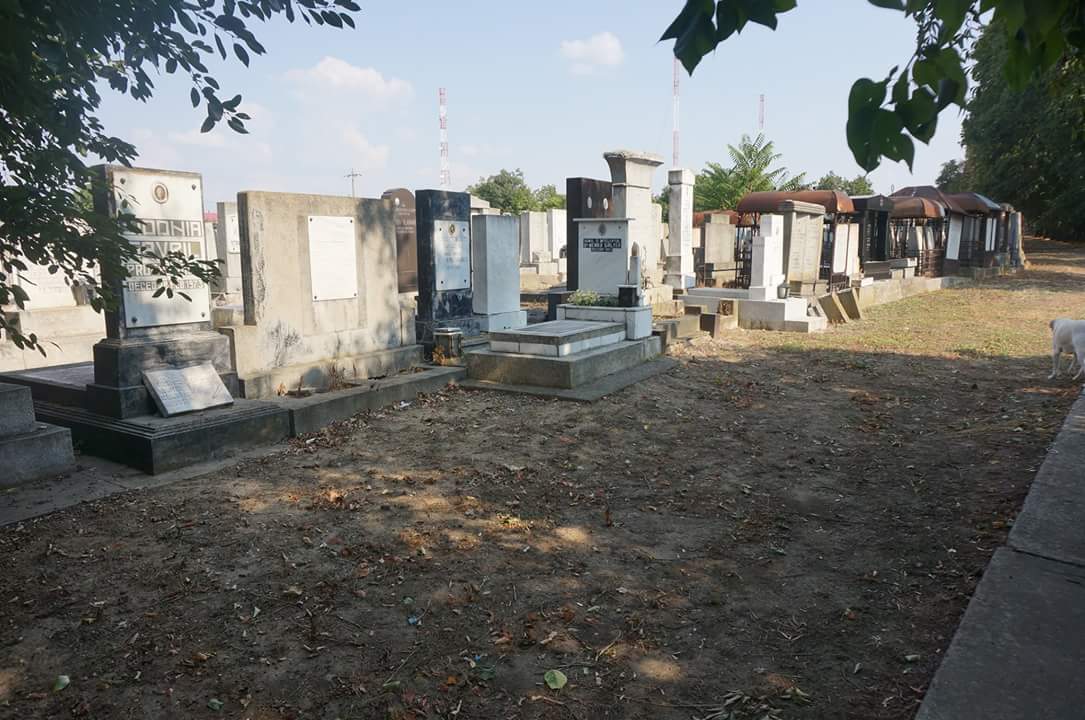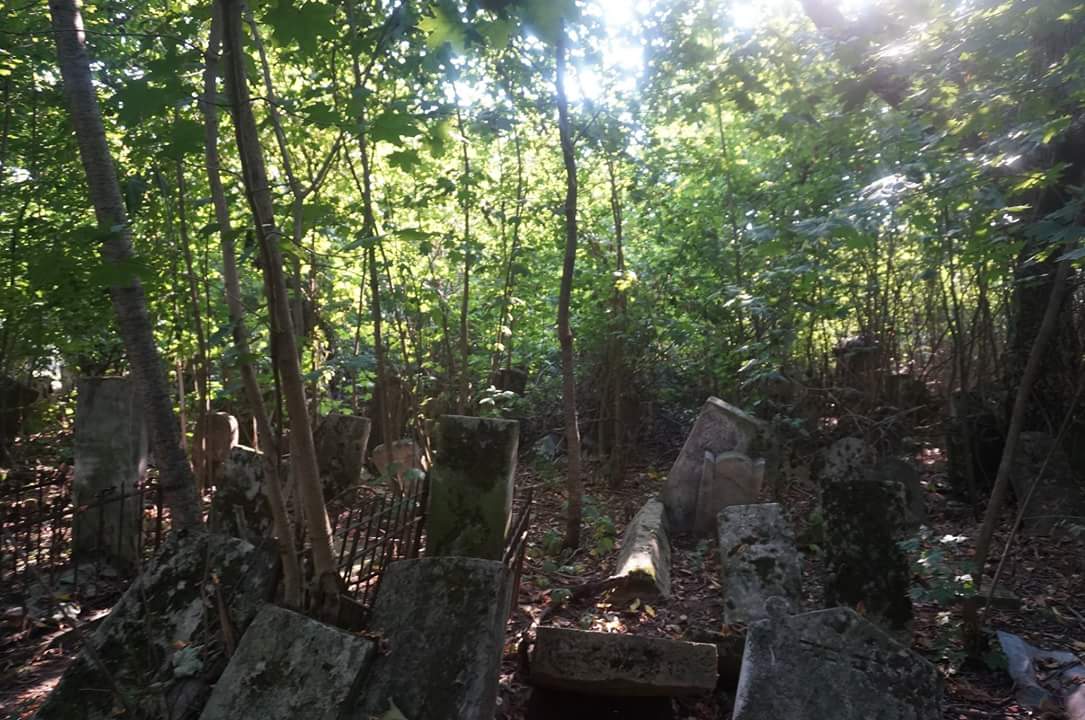 Alternate names: Botoşani [Rom], Botoshan [Yid], Botoschan [Ger], Botoshani [Rus, Ukr], Botoszany [Pol], Botuschani, בוטושאן Hebrew. 47°45' N, 26°40' E, 230.6 miles N of Bucureşti. Jewish population: 16,817 (1899), 15,502 (1942). the capital city of Botoșani County, in northern Moldavia. Wikipedia.
Alternate names: Botoşani [Rom], Botoshan [Yid], Botoschan [Ger], Botoshani [Rus, Ukr], Botoszany [Pol], Botuschani, בוטושאן Hebrew. 47°45' N, 26°40' E, 230.6 miles N of Bucureşti. Jewish population: 16,817 (1899), 15,502 (1942). the capital city of Botoșani County, in northern Moldavia. Wikipedia.
Photos [January 2016]
- JOWBR: Jewish Cemetery
- Encyclopedia of Jewish Life (2001), pp. 177-178: "Botosani".
- Pinkas HaKehilot, Romania, Vol. 1 (1969), p. 29: "Botosani"
- JewishGen Romanian SIG
- Shtetlink [July 2010]
- Czernowitz Bukovina [Mar 2014]
- Jewish Bukovina [Mar 2014]
- Botosani Jewish Community, Address: Str. 1 Decembrie 54, Tel: (231) 514.659. This small but still active and aging Jewish community exists with a renovated synagogue. [January 2011]
- REFERENCE: This email address is being protected from spambots. You need JavaScript enabled to view it.. Like Shells on a Shore. Projekt 36, Bern, Switzerland, 2010. To order, contact Mr. Geissbuhler. history and photographs. [December 2010]
- REFERENCE: Ruth Gruber. Jewish Heritage Travel: A Guide to East-Central Europe. New York: John Wiley & Sons, Inc., 1992- 201, 212-213 Aron ha Kodesh 212; Located at 47°45' 26°40' Photos courtesy This email address is being protected from spambots. You need JavaScript enabled to view it. [2008]
- REFERENCE: United Botoshaner American Brotherly and Benevolent Association (New York, N.Y.) Title: Records, 1916-1973.Description: .5 linear ft. Notes: Landsmanshaft incorporated in 1904 and reorganized in 1906 by Jewish immigrants from Botosani, Romania. ...YIVO collections are in Yiddish, Russian, Polish, English, Hebrew, and other European and non-European languages. Location: YIVO Institute for Jewish Research, New York, NY. Control No.: NXYH89-A758 [December 2000]
- REFERENCE: county map. [December 2000]
- REFERENCE: http://www.rotravel.com/counties/botosani/index.htm [December 2000]
- Jews settled in this historic market town in NE Romania in the 17th century/ By the 19th century, the community was one of the largest in the province of Moldova. Approximately 11,000 Jews lived in Botosani beforeWWII. Only a few dozen survived and remained. .
-
Great Synagogue "Hoihe Sil" at Str. Marchian 1 is the only remaining synagogue in the city. One of the oldest and richly decorated, the Great Synagogue of Botosani was built in 1834. The interior features naïve scenes of Jerusalem, biblical animals, and symbols representing the tribes of Israel. Intricate chandeliers adorn the ceiling/ A lavishly carved and brightly painted Aron Kodesh overhangs the sanctuary.
CEMETERIES:
- Cemetery photos of either below. [Mar 2014]
BOTOSANI (I): (Botosani judet) US Commission No. _
The cemetery is located at str. Penes Curcanul no. 6, Botosani judet, Moldavia region at 47°40' 26°45', 45 km from Suceava. Present town population is over 100,000 with 0-100 Jews.
- Local Authority: Mayor Egner Florin, Botosani, Botosani judet. Phone: 511712.
- Religious Authority: The Jewish Community of Botosani, Soseaua Nationalã no. 220, Botosani. Phone: 514659
- Regional Authority: The Federation of the Jewish Communities of Romania, Sf. Vineri str., no. 9-11, sector 3, Bucharestiasi, Romania.
- Interested: "A.D. Xenopol" Institute of History, Lascar Catargi str., no. 15, 6400- Iasi (Iasi judet), Romania. Tel. 032/212614; e-mail: This email address is being protected from spambots. You need JavaScript enabled to view it.. Director: Alexandru Zub
- Caretaker with key: Hosmaniuc Gheorghe, str. Penes Curcanul no. 22, Botosani, Botosani judet.
The 1774 Census registered 41 Jewish families, 1821 Census registered 573; and the 1831 Census registered 909 Jewish families. The 1852 Census registered 1,935 Jewish inhabitants. The 1930 Census registered 11407 Jewish inhabitants. In 1740, the Chevra Kadisha is mentioned. In 1941, the Jews were deported to Caracal (Romania) and Transberbestinistria. Prominent residents include Iacov Psanter, historian of the Jewish community (born 1820). This Jewish cemetery was established in the 18th century. The last known Jewish burial in cemetery was in the 19th century. Ungureni (Botosani judet), Bucecea (Botosani judet), Cristesti (Botosani judet), Stefanesti (Botosani judet) also used the unlandmarked Conservative cemetery, about 0.5 km from the congregation that used it.
The isolated suburban flat land has no sign or marker. Reached by turning directly off a public road, access is entirely closed. A continuous masonry wall and a gate that locks surround the site. The pre- and post-WWII size is 70 m. X 80 m. 20 to 100 tombstones are visible with 1 to 20 in original location and 1 to 20 not in original location. 50% - 75% of the tombstones are broken or toppled. Vegetation overgrowth and water drainage not problems.
Tombstones date from the 19th century. The marble and limestone memorial markers are rough stones or flat shaped stones, some with portraits and/or inscriptions are in Hebrew. The national Jewish community owns the cemetery property used for agricultural purposes. Adjacent properties are residential. Compared to 1939, the cemetery boundaries enclose the same area.
Rarely, private visitors (Jewish or non-Jewish) stop. Local residents visit the site. No maintenance but regular care by an unpaid caretaker. No structures. Security, weather erosion, vandalism, and pollution are moderate threats.
Lucian Nastasa, Clinicilor str., no. 19, Cluj, Romania, tel. 064/190107. Email: This email address is being protected from spambots. You need JavaScript enabled to view it. completed the survey on July 24, 2000 using the following documentation:
- E.Schwarzfeld, Din istoria evreilor: împopularea, reîmpopularea si întemeierea tîrgurilor si tîrgusoarelor în Moldova, Bucuresti, 1894.
- N.Sutu, Notiti statistice asupra Moldaviei, Iasi, 1852.1899.
- I.M.Dinescu, Fiii neamului de la 1859 la 1915. Statistica sociala pe întelesul tuturora, Iasi, Institutul de Arte Grafice N.V.Stefaniu, 1920.
- Leonida Colescu, Analiza rezultatelor recensamîntului general al populatiei Romaniei de la 1899, cu o prefata de Sabin Manuila , Bucuresti, Institutul de statistica, 1944.
- I.Kara, Inscriptii funerare ebraice din judetul Botosani, în "Memoria Antiquitatis", II, 1970, p. 523-531.
- Pinkas Hakehillot, Encyclopedia of Jewish Communities Romania, I-II, Jerusalem, 1980.
- D.Ivanescu, Populatia evreiascã din orasele si tîrgurile Moldovei între 1774-1832 , în "Studia et acta historiae iudaeorum Romaniae", II, Bucuresti, Edit.Hasefer, 1997, p. 59-65.
- Marius Mircu, Pogromurile din Bucovina si Dorohoi, Bucuresti, Edit.Glob, 1945.
- G. Ghintzer, Dosarul documentelor comunitatii israelite din Botosani, Botosani, 1900.
He visited July 26, 2000 and interviewed Chiriac Petru, com. Bivolari, Iasi judet Hosmaniuc Gheorghe, str. Penes Curcanul no. 22, Botosani, Botosani judet. [June 2002]
Botosani's large Jewish Cemetery includes a newer section with tombstones dating from the 19th century and an original old section with wonderfully carved tombstones:
BOTOSANI (II): (Botosani judet) US Commission No. _
See Botosani I for town details.
The cemetery is located at str. Mihai Eminescu no. 403, Botosani judet, Moldavia region at 26°45' 47°40', 45 km from Suceava. See Botosani I for town details.
- Caretaker with key: Iordache Ilie, str. M. Eminescu no. 403, Botosani, Botosani judet
This Conservative Jewish century was established in the 17th century. The last known Jewish burial in cemetery was in 19th century. Ungureni (Botosani judet), Bucecea (Botosani judet), Cristesti (Botosani judet), and Stefanesti (Botosani judet) also used this unlandmarked site, 1.5 km from the congregation that used it.
The isolated flat urban cemetery location has a sign in Romanian. Reached by turning directly off a public road, access is open with permission. A continuous masonry wall and a gate that locks surround the cemetery.
The pre- and post-WWII size is 120 m X 100 m. 100 - 500 tombstones are in the cemetery.
1 to 20 are not in original location and more than 75% toppled or broken. Vegetation overgrowth is a seasonal problem, preventing access. Water drainage is good all year.
Tombstones date from the 19th century. The marble, limestone, sandstone tombstones and memorial markers are rough stones or boulders, flat shaped stones, finely smoothed and inscribed stones, and flat stones with carved relief decoration. Some have portraits on the stones. Inscriptions are in Hebrew.
The national Jewish community owns the cemetery property used for agricultural purposes. (crops or animal grazing). Adjacent properties are residential and a military unit. Compared to 1939, the cemetery boundaries enclose the same area. Rarely, private visitors (Jewish or non-Jewish) stop.
The never-vandalized cemetery has had no maintenance, bberbestiut the Jewish Community of Botosani pays the regular caretaker. No structures. Weather erosion is a moderate threat. Pollution, vegetation, and vandalism are slight threats.
This email address is being protected from spambots. You need JavaScript enabled to view it., Clinicilor str., no. 19, Cluj, Romania, tel. 064/190107 completed the survey on July 22, 2000 using the following documentation:
- E.Schwarzfeld, Din istoria evreilor: împopularea, reîmpopularea si întemeierea tîrgurilor si tîrgusoarelor în Moldova, Bucuresti, 1894.
- N.Sutu, Notiti statistice asupra Moldaviei, Iasi, 1852.
- George I.Lahovari, Marele dictionar geografic al Romaniei, 5 vol., Bucuresti, Edit.Socec, 1899.
- I.M.Dinescu, Fiii neamului de la 1859 la 1915. Statistica sociala pe întelesul tuturora, Iasi, Institutul de Arte Grafice N.V.Stefaniu, 1920.
- Leonida Colescu, Analiza rezultatelor recensamîntului general al populatiei Romaniei de la 1899, cu o prefata de Sabin Manuila , Bucuresti, Institutul de statistica, 1944.
- I.Kara, Inscriptii funerare ebraice din judetul Botosani, în "Memoria Antiquitatis", II, 1970, p. 523-531.
- Pinkas Hakehillot, Encyclopedia of Jewish Communities Romania, I-II, Jerusalem, 1980.
- D.Ivanescu, Populatia evreiascã din orasele si tîrgurile Moldovei între 1774-1832 , în "Studia et acta historiae iudaeorum Romaniae", II, Bucuresti, Edit.Hasefer, 1997, p. 59-65.
- Marius Mircu, Pogromurile din Bucovina si Dorohoi, Bucuresti, Edit.Glob, 1945.
- G. Ghintzer, Dosarul documentelor comunitatii israelite din Botosani, Botosani, 1900.
He visited July 26, 2000 and interviewed Iordache Ilie, str. M. Eminescu no. 403, Botosani, Botosani judet. [June 2002]
BOTOSANI (III): (Botosani judet) US Commission No. _ see Botosani I for town details.
- Caretaker with key: Iordache Ilie, str. M. Eminescu no. 403, Botosani, Botosani judet.
This unlandmarked Orthodox Jewish century was established in the 19th century. The last known Jewish burial in cemetery was in May 2000. Ungureni (Botosani judet), Bucecea (Botosani judet), Cristesti (Botosani judet), Stefanesti (Botosani judet) also used this cemetery, 1.5 km from the congregation that used it.
The isolated flat urban cemetery location has a sign in Romanian mentioning the Jewish Community. Reached by turning directly off a public road, access is open with permission. A continuous masonry wall and a gate that locks surround the site.
The pre- and post-WWII size is 800 m X 250 m. More than 5,000 graves are visible in the cemetery. 1 to 20 are not in original location. More than 75% are toppled or broken. Vegetation overgrowth is a seasonal problem, preventing access. Water drainage is good all year.
No special sections. Tombstones date from the 19th and 20th centuries. The marble, granite, limestone, sandstone, slate, and other materials tombstones are rough stones or boulders, flat shaped stones, finely smoothed and inscribed stones, flat stones with carved relief decoration, double tombstones, sculpted tombstones, and multistone monuments. The tombstones have iron decorations or lettering, with bronze decorations or lettering, with other metallic elements, portraits on stones, and metal fences around graves. Inscriptions are in Hebrew, Yiddish, Polish, German, and Romanian.
The national Jewish community owns the property now used for Jewish cemetery purposes only. Adjacent properties are a military unit. Compared to 1939, the cemetery boundaries enclose the same area. Frequently, organized Jewish group tours or pilgrimage groups, private visitors (Jewish or non-Jewish), and local residents local residents stop. The never vandalized cemetery has had no maintenance but has a regular caretaker paid by the Jewish Community of Botosani.
The preburial house has a tahara (table), a catafalque, and wall inscriptions. Security and vandalism are a moderate threat. Weather erosion and vegetation are slight threats.
This email address is being protected from spambots. You need JavaScript enabled to view it., Clinicilor str., no. 19, Cluj, Romania, tel. 064/190107 completed the survey on July 22, 2000 using the following documentation:
- E.Schwarzfeld, Din istoria evreilor: împopularea, reîmpopularea si întemeierea tîrgurilor si tîrgusoarelor în Moldova, Bucuresti, 1894.
- N.Sutu, Notiti statistice asupra Moldaviei, Iasi, 1852.
- George I.Lahovari, Marele dictionar geografic al Romaniei, 5 vol., Bucuresti, Edit.Socec, 1899.
- I.M.Dinescu, Fiii neamului de la 1859 la 1915. Statistica sociala pe întelesul tuturora, Iasi, Institutul de Arte Grafice N.V.Stefaniu, 1920.
- Leonida Colescu, Analiza rezultatelor recensamîntului general al populatiei Romaniei de la 1899, cu o prefata de Sabin Manuila , Bucuresti, Institutul de statistica, 1944.
- I.Kara, Inscriptii funerare ebraice din judetul Botosani, în "Memoria Antiquitatis", II, 1970, p. 523-531.
- Marius Mircu, Pogromurile din Bucovina si Dorohoi, Bucuresti, Edit.Glob, 1945.
- D.Ivanescu, Populatia evreiascã din orasele si tîrgurile Moldovei între 1774-1832 , în "Studia et acta historiae iudaeorum Romaniae", II, Bucuresti, Edit.Hasefer, 1997, p. 59-65.
- Pinkas Hakehillot, Encyclopedia of Jewish Communities Romania, I-II, Jerusalem, 1980.
- He visited July 26, 2000 and interviewed Iordache Ilie, str. M. Eminescu no. 403, Botosani, Botosani judet. [June 2002]
Photos courtesy This email address is being protected from spambots. You need JavaScript enabled to view it. [2008],
Photos courtesy Ariel Silverstone [September 2016]
[UPDATE] Photos of Botosani Jewish Cemetery [April 2015]
[UPDATE] Photos by Charles Burns [July 2018]

